Paspaley Pearl: Australia’s most luxurious Kimberley cruise rewards those who take their time
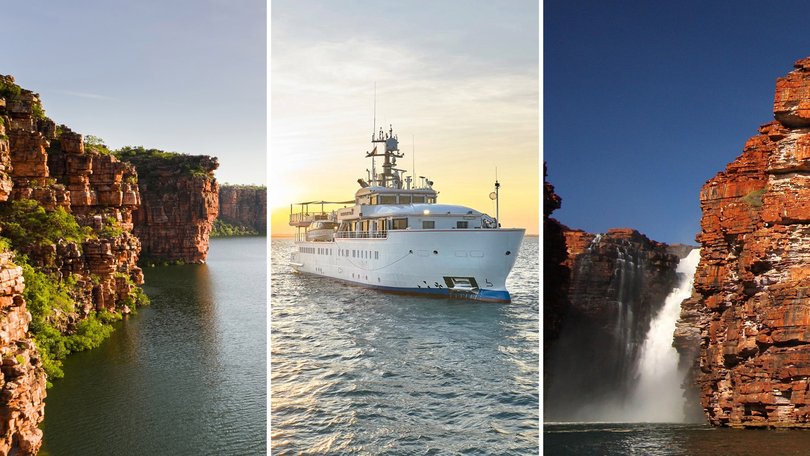
There are some places that reward haste. The Kimberley is not one of them.
Here in Australia’s remote north-west, the horizon always seems to fold in on itself — a smear of ochre and salt, a coastline both fractured and eternal. Nothing is close. Distances deceive.
The tide doesn’t creep, it crashes, rising and falling more than 12 metres a day, inhaling and exhaling with a rhythm that belongs to another time.
Aboard Paspaley Pearl, the new 15-suite expedition yacht from Australia’s oldest pearling dynasty, that’s exactly what you do. With just 30 guests — no theatre, no gala night and no fixed script — the vessel offers something increasingly rare: the space to be still.
ROAM. Landing in your inbox weekly.
A digital-first travel magazine. Premium itineraries and adventures, practical information and exclusive offers for the discerning traveller.
By continuing you agree to our Terms and Privacy Policy.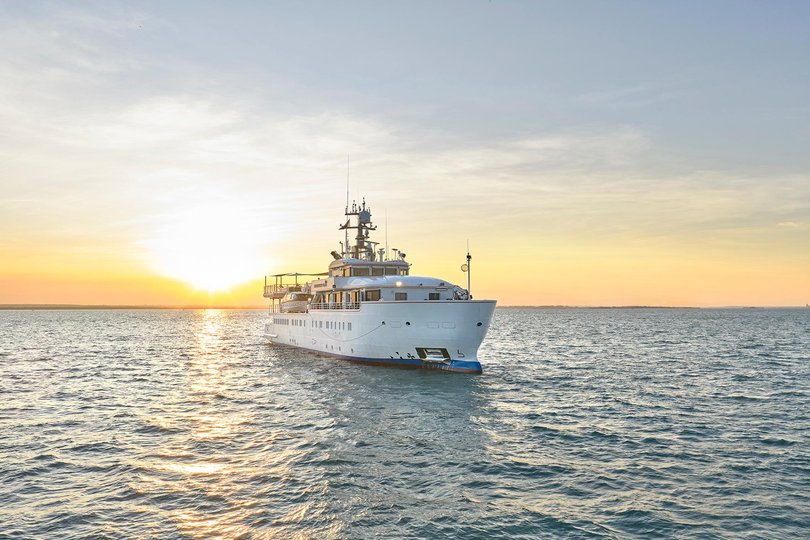
Not performative stillness, but a kind that invites awareness. What the ship trades in is not excess, but access: to wilderness, to story, and to a coastline that, despite being around since the beginning of time, has changed little in tens of thousands of years.
Luxury, unscripted
The tone is set from the moment the Paspaley Pearl slips out of Broome — champagne, a salt breeze and the faint shimmer of a stingray off the bow.
Across the next 11 days, the voyage drifts through the Lacepede Islands, Bonaparte Archipelago, Prince Regent River and the ancient rock art sites of Bigge Island, tracing a loose 1000km arc towards Wyndham on the outskirts of Kununurra.
Onboard, the design resists opulence.
Interiors are brushed timber, brass, neutral linens. Art nods to the region’s 65,000 years of Indigenous history, but doesn’t distract from what lies outside the window.
Suites are spacious, the sundeck holds a spa, and a marina platform launches Zodiacs that navigate tidal rivers and rock-lined inlets.
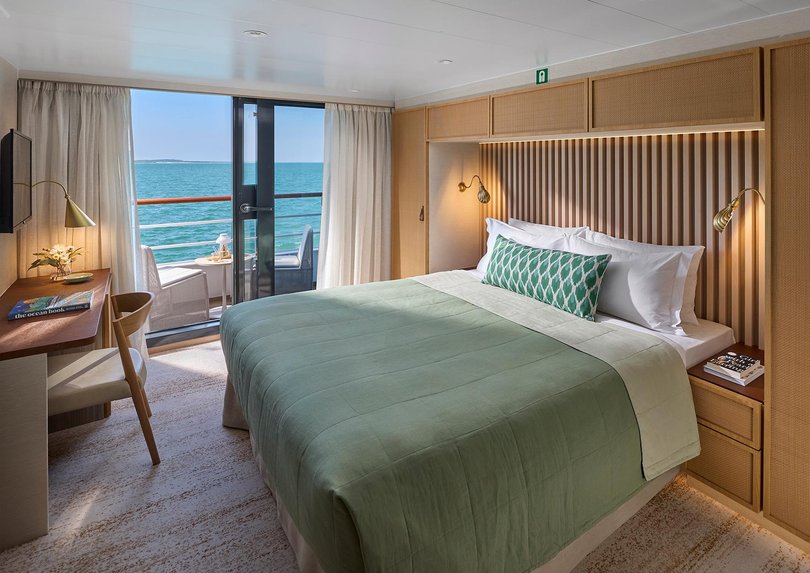
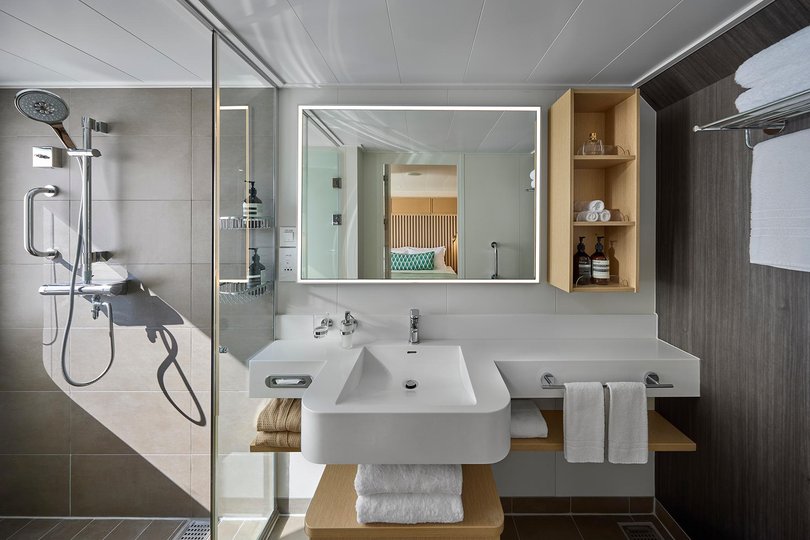
But the real indulgence is flexibility. If dolphins appear, the schedule shifts. If whales breach, the ship slows and changes orientation. If no one wants to move, no one moves.
Food too, follows this relaxed pace. Prawns are grilled on remote beaches. Oysters come with finger lime vinaigrette and West Australian riesling. Dinners served in the Ocean Deck restaurant feature whatever guests caught that day — perhaps Spanish mackerel, maybe bluefin tuna. The house pour? Lallier champagne.
Where the edges shift
Nothing in the Kimberley holds still for long — not the coastline, not the light, not even the land itself. Tides rise and fall with the force of a natural breathing apparatus, swallowing whole reefs then revealing them hours later like a sleight of hand.
Montgomery Reef is the most dramatic example. As the ocean recedes, an ancient limestone shelf appears to levitate from the water.
Hundreds of waterfalls gush from its flanks, while reef sharks flick through narrow channels and green turtles surface like buoys. It feels less like a reef than a living organism.
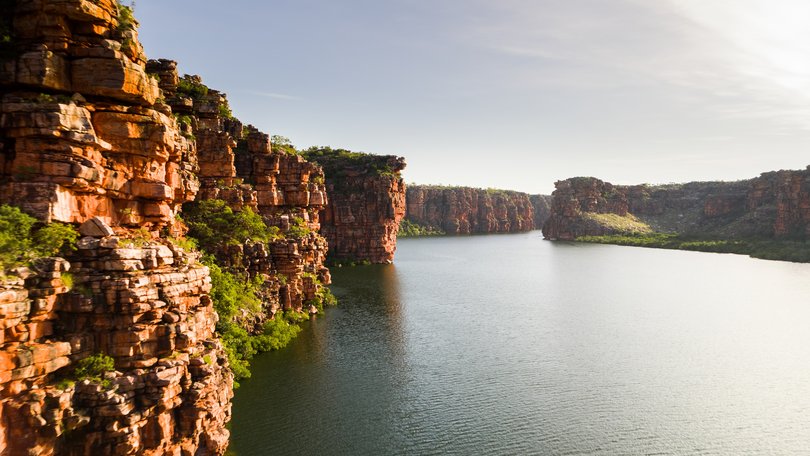
There’s similar drama at the Horizontal Falls, where tidal currents rush between two narrow sandstone gorges with such speed they create a horizontal waterfall — a phenomenon so rare it’s been described as one of the greatest natural wonders in the world.
Zodiacs time their entry precisely, skimming across the boiling water with just seconds to spare.
In the far north, the Bonaparte Archipelago splinters the mainland into a mosaic of rust-red islands and aquamarine shallows. There are no markers here, only reef-strewn passages, overhanging caves and beaches where the only footprints are yours.
Zodiacs navigate this labyrinth by instinct and tide charts, slipping between sandstone flanks and mangrove-lined creeks.
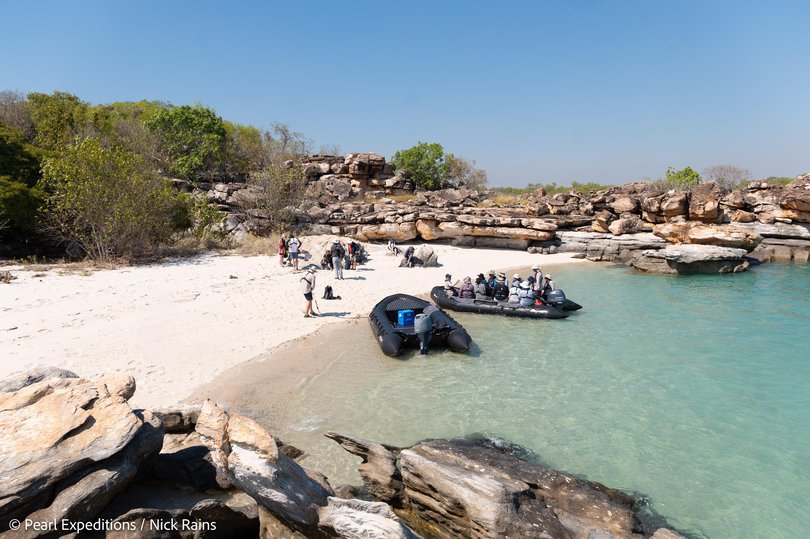
Wildlife flourishes in the in-between zones.
The Lacepede Islands, flat and unassuming at first glance, turn out to be a nesting haven for brown boobies and green turtles, while just offshore, reef sharks and enormous salties circle with casual grace.
Not far off the cliffs of Bigge Island shelter galleries of Gwion Gwion rock art — fine-lined human forms painted in ochre, so delicate they seem almost whispered onto stone. Millennia ago. The caves that hold them are shaded, sacred, and empty but for the pulse of history that sits in the air like heat.
Then there’s Kuri Bay, where the story folds inward.
This is where it all began for the Paspaley family, who first arrived in the Kimberley in the 1930s, lured by the promise of wild shell beds and pristine waters.
They would go on to transform Australia’s pearling industry, pioneering the cultivation of South Sea pearls and creating what is now the world’s most respected producer.
The new Pearl Expeditions venture sees the family return to their roots, this time in partnership with Sarina Bratton AM — the doyenne of luxury cruising in Australasia.
Bratton first brought high-end expedition cruising to the Kimberley in 2004 when she founded Orion Expedition Cruises, with Paspaley as a key investor.
Two decades and one Ponant tenure later, she’s back — helming a vessel shaped by both deep legacy and clear vision.

Paspaley’s first pearling base still operates in Kuri Bay, not as museum, but as a working site.
After a tour guests are served pearl meat ceviche beside weathered timber buildings.
Later, in the Osborn Islands, guests are invited aboard a seeding ship where Japanese technicians perform the precise and invisible act of placing a nucleus inside an oyster.
It’s a procedure that takes seconds but can define years of cultivation. The result, if nature co-operates, is a pearl among the world’s most rare and lustrous.
No need to rush
Unlike many small-ship expeditions, Paspaley Pearl doesn’t pretend the Kimberley needs decoding. It doesn’t overshare.
The guides are expert but not intrusive, and knowledge is offered gently, always grounded in country, often delivered while barefoot at the bow.
There are days when the most powerful moment is the absence of noise — when the wake of a crocodile gliding from a sandbank says more than any narration; when the warm metallic scent of salt on skin after a rock pool swim lingers long into the evening.
By the time we reach the mangrove deltas outside Wyndham, the coastline hasn’t been “done”. It’s been revealed — fragment by fragment, tide by tide, with no two guests seeing it the same way.
THE FACTS
Paspaley Pearl operates in the Kimberley between April and September. During other months, she also sails to Papua New Guinea, Borneo, East Indonesia and Raja Ampat.
